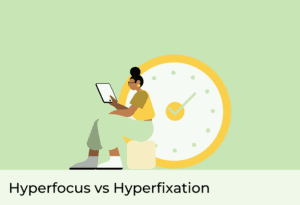
Have you ever found yourself completely engrossed in a task? You get lost in whatever you are doing, tune out the outside world, and lose track of time. In individuals with Attention Deficit Hyperactivity Disorder, this is actually something that commonly occurs. It is called hyperfocus.
Another similar but distinct state of intense focus is called hyperfixation. This state of intense focus is often seen in individuals with autism spectrum disorder, and it’s not as commonly discussed as hyperfocus. Both hyperfocus and hyperfixation are fascinating states of mind that can be a double-edged sword, both a blessing and a curse, for individuals experiencing them. They can be disruptive to your everyday life and take your focus away from what is important but also be harnessed to learn a new skill or ability.
In this article, we will explore the similarities and differences between hyperfixation vs hyperfocus. We’ll delve into the positive and negative aspects of each state, and how you can use them for your benefit. Whether you’re someone who experiences hyperfocus or hyperfixation or are simply curious to learn more about the positive psychology of these traits, read on![1][2]
Hyperfocus: Lose Track Due to Concentration
Hyperfocus is a concentration trait that can be observed in individuals with Attention Deficit Hyperactivity Disorder (ADHD). It is characterized by an intense level of or “hyper focus” on a specific task or activity. Often, this causes the individual to completely tune out or ignore the surrounding environment. When utilized effectively, hyperfocus can lead to increased productivity and creativity. This state of concentration allows individuals to complete tasks more efficiently and effectively. However, hyperfocus has both positive and negative aspects. While hyperfocus can be helpful in certain situations, on the flip side, it can also lead to neglect of other responsibilities or basic self-care, which can result in burnout. Additionally, it can be challenging to break out of a state of hyperfocus, leading to difficulties with time management or meeting deadlines.
How to tell if you have hyperfocus
Have you ever been so focused on a task that you lost track of time and tuned out your surrounding environment? For example, working on a project for hours on end without realizing you skipped lunch. If so, you may have experienced hyperfocus. Hyperfocus is often seen in individuals with attention deficit hyperactivity disorder and is characterized by an intense level of focus on a specific task or activity. This is in contrast to some neurotypical people, who may have trouble focusing.
If you’re not sure whether you’ve experienced hyperfocus before, here are some signs to look out for:[4]
- You become completely immersed in a task, experiencing flow states.
- You can tune out distractions and external stimuli, even if they are loud or disruptive.
- You indulge yourself in a task and lose track of time, forgetting to eat, drink, or take breaks.
- You feel a sense of satisfaction and accomplishment after completing a task in a state of hyperfocus.
- You find it difficult to stop working on a task, even if you’re tired or it’s time to move on to something else in your daily life.
- You start binge watching a particular TV show without realizing it
If you can relate to these signs, you may be a hyperfocused person. So, the next time you find yourself completely absorbed in a task, take a moment to reflect on whether you’re experiencing hyperfocus. Recognizing this trait can help you manage it effectively, leading to enhanced productivity and success. The next section will go in greater detail about these characteristics you should look out for.
Characteristics of Hyperfocus
- Intense concentration: Hyperfocus is characterized by an intense level of concentration that allows individuals to work on a specific task or activity for extended periods of time. People are able to block out distractions and focus all their attention on the task at hand.
- The ability to block out distractions: People in hyperfocus have the ability to ignore external stimuli and focus on the task at hand. This can be an advantage over neurotypical people since you can block out distractions.
- Increased productivity: When utilized effectively, hyperfocus can lead to increased productivity. You are able to complete tasks more efficiently and effectively due to your heightened level of concentration.
- A sense of accomplishment: Completing a task during a state of hyperfocus can be incredibly satisfying and rewarding. This sense of accomplishment can feel amazing.
- Pleasure and satisfaction derived from completing a task: Individuals who experience hyperfocus often derive pleasure and satisfaction from completing a task.
Overall, the characteristics of hyperfocus can be both positive and negative. While hyperfocus can lead to increased productivity and a sense of accomplishment in essential tasks, it can also lead to neglect of other life responsibilities, mental health issues, anxiety disorders and difficulties with time management.
Positives and negatives of hyperfocus
Hyperfocus can have both positive and negative aspects, depending on the situation. Here are some examples:
Positives
- Hyperfocus can help you get things done quickly and efficiently while in the flow state, without distractions getting in the way.
- It feels great to complete a task while in a state of hyperfocus, leading to a sense of accomplishment.
- You may be more creative and come up with innovative solutions when you are hyperfocused.
- For some people that have procrastination problems, hyperfocus can help them complete their tasks.

Negatives
- Hyperfocus can lead to burnout, as individuals may become so absorbed in a task that they neglect other responsibilities or basic self-care.
- It can be difficult to break out of hyperfocus, leading to a poor sense of time management or difficulty to stay organized.
- For those around that do not understand your hyperfocus, it can be frustrating as to why you are so absorbed in a particular task.
- If you become overly reliant on hyperfocus, you may struggle with completing tasks when you are not in that state, leading to inconsistency in productivity.
Hyperfocus in Children
Hyperfocus is a common trait seen in ADHD kids. It is characterized by an intense level of concentration on a specific task or activity. Children with attention deficit hyperactivity disorder tend to not want to do things they are not interested in However, when they do find something they are interested in, they can become hyperfocused and completely ignore the surrounding environment. This can be both positive and negative.
On the positive side, hyperfocus can lead to increased productivity and creativity when a child is working on something that interests them. It can also lead to a sense of accomplishment when they complete the task. However, hyperfocus can also cause children to ignore other responsibilities, such as homework or chores, and cause difficulty with time management and social interactions. Plus, focusing on the wrong things, such as playing video games, can be bad for development, especially in a child with ADHD brain. This can result in burnout social isolation, anxiety disorders, and frustration for both the child and their caregivers.
It is important for parents and educators to recognize the signs of hyperfocus in children with attention deficit hyperactivity disorder. By understanding this trait, they can identify triggers and can help children manage their time and responsibilities effectively. This can lead to enhanced productivity and success both in and out of the classroom.[5][6][7]
Hyperfixation: Taking Up a Special Interest
Hyperfixation occurs in individuals with autism spectrum disorder (ASD). It is a state of intense focus or a hyper fixation on a particular subject, specific interest or topic, to the point where it becomes all-consuming. Hyperfixation can be a positive attribute of autism spectrum disorders, as it can lead to the development of specialized skills and intense interest and knowledge of specific subject. Read on to learn about how to harness and overcome hyperfixation.
How to tell if you have hyperfixation
If you have ever been so interested topic or activity that it felt like nothing else in the world existed or found yourself spending hours researching a topic or spending time learning a new life skill or particular hobby, without realizing how much time has passed, you may have experienced hyperfixation.
Hyperfixation is a trait similar to hyperfocus, but with some important differences. It is characterized by an intense focus on special interests or topics, to the point where it becomes an all-consuming intense passion. If you wonder if you have experienced hyperfixation before, ask yourself if you have felt any of the following:
- You become completely immersed in a topic or interest. You are so engaged that nothing else seems to matter.
- You have difficulty shifting your attention away from the interest, even when you need to focus on other tasks or responsibilities.
- You spend an enourmous amount of time researching or learning about the interest. Sometimes, this causes you to neglect other responsibilities or basic self-care.
- You derive pleasure and satisfaction from learning new things and becoming an expert on the topic.
- You may experience obsessive thoughts and behaviors related to the interest, such as constantly talking about it or feeling the compulsion to engage in related activities.
If these characteristics sound familiar to you, you may have experienced hyperfixation before. While it can be a positive trait, it’s important to be aware of its potential negative consequences. Finding the right balance is what will ultimately help you manage hyperfixation.
Positives and Negatives of Hyperfixation
Hyperfixation can be both a positive and negative trait. Here are some examples:
Positives
- Hyperfixation can lead to the development of specialized skills and knowledge in a specific area of interest.
- Becoming an expert on a specific topic can be extremely satisfying
- Hyperfixation can be a useful tool for those who struggle with motivation or difficulty focusing.
- When harnessed effectively, hyperfixation can lead to increased productivity and creativity.
Negatives
- Hyperfixation can lead to neglect of other responsibilities or basic self-care, such as forgetting to eat or drink.
- It can be difficult to shift attention away from a topic, such as a video game, even when other tasks or responsibilities require attention.
- Those around you may not understand why you are so absorbed in a particular interest. This could be harmful to your personal relationships
- If you become overly reliant on hyperfixation, you may struggle with engaging in activities or interests outside of your hyperfixation, leading to a lack of balance in your life.
Now that you know more about hyperfixation, you can recognize the signs and better manage this trait. Who knows, you may even be able to use it to your advantage and develop expertise in an area of special interest![8][9]
Hyperfixation vs Hyperfocus: Understanding the Differences
Though hyperfocus and hyperfixation share similarities, and there are people that experience a combined type of the two, they are not the same. While hyperfocus is a state of intense concentration and sustained attention on a specific task, hyperfixation is a state of intense focus on a specific interest or topic. The root cause and underlying issues of the two are different. Furthermore, hyperfixation tends to be more all-consuming and obsessive than hyperfocus. Let’s dig in a bit deeper so you can learn to differentiate between the two!
The importance of differentiating the two
It is important to differentiate between hyperfixation vs hyperfocus because they are not the same thing. While they share some similarities, they are different states of mind with different characteristics. Recognizing the differences between hyperfixation vs hyperfocus can help individuals manage these traits more effectively and harness them to their advantage. For example, someone with attention deficit hyperactivity disorder may find that hyperfocus can help them complete tasks more efficiently, while someone with autism spectrum disorder may find that experiencing hyperfixation often can lead to the development of specialized skills and knowledge. By understanding these traits, individuals can better manage their time and responsibilities, leading to enhanced productivity and day to day functioning.
Similarities between hyperfixation vs hyperfocus
Hyperfixation vs hyperfocus share some similarities. Here are some more details about each bullet point:
- Both are states of intense focus that can be beneficial or detrimental: Both hyperfocus and hyperfixation involve intense levels of focus. While this can be helpful in certain situations, such as when trying to complete a task or learn about a new topic, it can also lead to neglect of other responsibilities or basic self-care. Additionally, both hyperfocus and hyperfixation can be detrimental when they lead to burnout or difficulties with time management.
- Both can lead to neglect of other responsibilities or basic self-care: When in a state of hyperfocus or hyperfixation, individuals may become so absorbed in a task or interest that they neglect other responsibilities or basic self-care, such as eating, drinking, or taking breaks. This can lead to burnout and difficulties with time management.
- Both can be difficult to break out of once entered: When in a state of hyperfocus or hyperfixation, individuals may find it difficult to shift their attention away from the task or interest at hand, even when other tasks or responsibilities require attention. This can lead to difficulties with time management or meeting deadlines.
- Both can lead to a sense of satisfaction and accomplishment: Completing a task or learning about a new topic in a state of hyperfocus or hyperfixation can be incredibly satisfying and rewarding. This sense of accomplishment can lead to increased self-confidence and motivation.
Differentiating hyperfixation vs hyperfocus
- Hyperfocus is a state of intense concentration on a task or activity; hyperfixation is a state of intense focus on a topic or interest. In other words, hyperfocus is task-oriented, while hyperfixation is interest-oriented.
- Hyperfocus is associated with attention deficit hyperactivity disorder; hyperfixation is associated with autism spectrum disorder. While hyperfocus is often seen in individuals with ADHD, hyperfixation is more commonly associated with individuals with autism spectrum disorder.
- Hyperfocus can increase productivity and creativity; hyperfixation can lead to specialized skills and knowledge. While both hyperfocus and hyperfixation can be beneficial, hyperfocus is more likely to lead to increased productivity and creativity. Hyperfixation, on the other hand, can lead to the development of specialized skills and knowledge in a particular area of interest.
How you can take advantage of your condition
Examples of how to take advantage of Hyperfocus
- Use a timer: Set a timer for a specific amount of time and use hyperfocus to complete a task during that time frame. This can help you stay on track and prevent burnout from working on a task for too long.
- Break up tasks: If you struggle with hyperfocus to the point where you neglect other responsibilities, try breaking up tasks into smaller, more manageable chunks. This can help you stay focused on a task while also ensuring that you have time for other responsibilities.
Examples of how to take advantage of Hyperfixation
- Find a career or hobby that aligns with your hyperfixation: If you have a hyperfixation on a particular topic or interest, consider finding a career or hobby that allows you to pursue that interest. For example, if you’re hyperfixated on computer programming, consider pursuing a career in software development.
- Use hyperfixation as a tool for learning: Hyperfixation can be a powerful tool for learning about a new topic or skill. If you’re interested in learning about a new topic, allow yourself to become hyperfixated on it for a period of time. This can help you absorb information more effectively and become an expert on the topic.
By taking advantage of hyperfixation vs hyperfocus, individuals can harness these traits to their advantage and pursue their interests while still maintaining balance and important tasks in their daily lives. However, if you feel like either condition is impacting your well being and you start having negative thoughts, it is important to seek professional support or expert opinion. Additional mental health conditions can arise, such as obsessive compulsive disorder, so having professional support, a proper coping mechanism, and mindfulness techniques, such as mindfulness meditation, can prevent worse things happening.[10][11][12]
Use an App to Understand Your Condition
Hyperfixation and hyperfocus can be both positive and negative, and distinguishing between the two is very important. However, the CareClinic can make things a lot easier. You can easily track your symptoms within the app as they occur throughout the day. That way, you can look at it afterwards and try to figure out if you have hyperfixation vs hyperfocus, neither, or both!
There is also a diary section where you can try to keep organized and prevent yourself form be overtaken by either condition. This will hopefully allow you to harness the power of either condition for the best, develop a coping mechanism when it becomes overwhelming, and live your best life in the most productive ways!
In conclusion, hyperfocus and hyperfixation are two fascinating states of intense concentration that can be both beneficial and detrimental, depending on the situation. While hyperfocus is a trait commonly seen in individuals with ADHD, hyperfixation is often seen in individuals with autism spectrum disorder. Both traits can lead to increased productivity and a sense of accomplishment, but they can also lead to neglect of other responsibilities or basic self-care. It is important to recognize these traits and find ways to manage them effectively in order to enhance productivity and success. By understanding hyperfocus and how to manage hyperfixation, individuals can better harness these traits to their advantage and pursue their interests while still maintaining balance in their lives.
Sources:
- ADDitude (2023). Hyperfocus: The ADHD Phenomenon of Intense Fixation. https://www.additudemag.com/understanding-adhd-hyperfocus/
- Healthline (2023). ADHD and Hyperfocus. https://www.healthline.com/health/adhd/adhd-symptoms-hyperfocus
- Nation Institute of Mental Health (2023). Attention-Defecit/Hyperactivity Disorder. https://www.nimh.nih.gov/health/topics/attention-deficit-hyperactivity-disorder-adhd
- United We Care (2021). Hyperfixation vs. Hyperfocus: ADHD, Autism, and Mental Illness. https://www.unitedwecare.com/hyperfixation-vs-hyperfocus/
References
- “Hyperfocus and the ADHD Brain: Intense Fixation with ADD”. https://www.additudemag.com/understanding-adhd-hyperfocus/
- “What a Hyperfixation Really Is”. https://time.com/7276835/hyperfixating-focus-autism-adhd-neurodivergent/
- “Understanding Hyperfocus and ADHD”. https://health.clevelandclinic.org/hyperfocus-and-adhd
- “Hyperfocus Symptoms: The Good, the Bad, and the Ugly”. https://www.additudemag.com/hyperfocus-symptoms-positives-negatives-strategies/
- “Hyperfocus symptom and internet addiction in individuals with attention-deficit/hyperactivity disorder trait – PMC”. https://www.ncbi.nlm.nih.gov/pmc/articles/PMC10061009/
- “Hyperfocus: the "Superpower" with a Literal Cost”. https://www.tevapharm.com/patients-and-caregivers/all-stories/adhd-hyperfocus-a-double-edged-sword/
- “Hyperfocus: The Flip Side of ADHD? – Child Mind Institute”. https://childmind.org/article/hyperfocus-the-flip-side-of-adhd/
- “Everything You Need to Know About Autism Hyperfixation”. https://www.cpduk.co.uk/news/everything-you-need-to-know-about-autism-hyperfixation
- “Autism Hyperfixation: What You Need to Know – Autism Parenting Magazine”. https://www.autismparentingmagazine.com/autism-hyperfixation/
- “Hyperfixation and ADHD | Psychology Today”. https://www.psychologytoday.com/us/blog/on-your-way-with-adhd/202409/hyperfixation-hyperfocus-and-adhd
- “Autistic Special Interests Vs ADHD Hyperfixations”. https://journalofcognitivepsychology.com/autistic-special-interests-vs-adhd-hyperfixations/
- “Understanding Hyperfixations: Managing Extreme Focus | Bay Area CBT Center”. https://bayareacbtcenter.com/hyperfixations-uncovered-harnessing-intense-focus-for-good/




